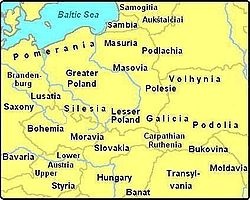This is an old revision of this page, as edited by Jakob Stevo (talk | contribs) at 16:01, 16 June 2004 (Ukraine includes Crimea and Dontsk, CE doesn't). The present address (URL) is a permanent link to this revision, which may differ significantly from the current revision.
Revision as of 16:01, 16 June 2004 by Jakob Stevo (talk | contribs) (Ukraine includes Crimea and Dontsk, CE doesn't)(diff) ← Previous revision | Latest revision (diff) | Newer revision → (diff)Central Europe is the region of Europe between Eastern Europe and Western Europe. There are no physical landmarks that would commonly be seen as its borders. Rather, it is a concept of shared history, in opposition against the East represented by the Ottoman Empire and Imperial Russia, and distinguished from the West as the area of relative political conservatism opposing the modern ideas acquired by overseas trading; and ultimately from the French Revolution.

Central Europe is frequently, particularly in the Western world, taken to include:
- the Alpine countries (from west to east):
- the Visegrád group (from north to south):
Several other countries also have regions that retain a Central European character, having historically been part of the central European kingdoms and empires such as the Holy Roman Empire, the Polish-Lithuanian Commonwealth, Imperial Germany, and the Habsburg monarchy. They include:
- Belarus
- Croatia (Slavonia and Northwest)
- Lithuania
- Romania (Transsylvania and Banat)
- Serbia (Vojvodina)
- Ukraine (Western parts)

Following World War II, large parts of Europe that were western in culture and history became part of the Eastern bloc, which effectively neutralized the concept of Central Europe. Following the fall of the Iron Curtain and the end of the Cold War, this distinction has again come into use, often to cover those countries that were Soviet satellites but now are members of NATO and the European Union, or about to become members.
The English term Central Europe was increasingly applied only to the countries east of the Iron Curtain (Hungary to Poland) to specify them as culturally akin countries under Soviet hegemony. This usage continued after the fall of the Iron Curtain when these countries started to undergo transition. Although occasionally the term is returning to its earlier, wider use, the differences between countries that were East and West of the Iron Curtain remain significant. This has also been recognized by the US Defense Minister Rumsfeld, who dubbed the countries of the Cold War definition of Central Europe as "New Europe".
The German term Mitteleuropa (or, alternatively, its literal translation into English, Mid-Europe) may sometimes be used in English to refer to this larger area. Note that it also has a specific meaning that refers to the territory that was under German cultural hegemony until World War I, usually with the exception of Balticum, including what remained of Austria and Germany in the interbellum.
Some used to joke that Central Europe is that part of the continent that is considered Eastern by Western Europe and Western by Eastern Europe.